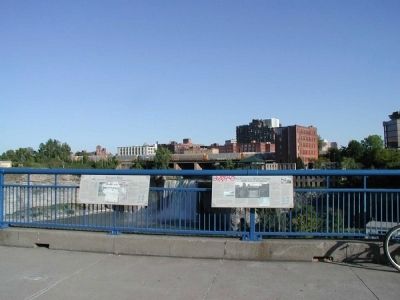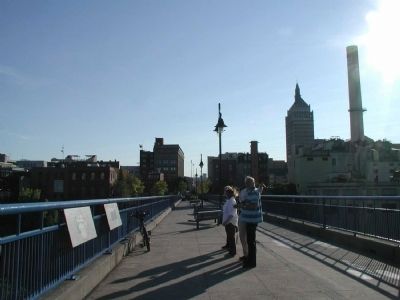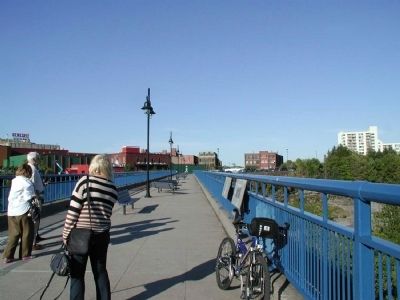Upper Falls in Rochester in Monroe County, New York — The American Northeast (Mid-Atlantic)
Genesee River Gorge: Centuries of Conflict in Pleasant Valley
Inscription.
The Genesee River valley, called by the Native Americans Gen-nis-he-yo (Geneseo) meaning "Pleasant Valley", was prized territory.
In addition to providing transportation and an abundant resource for salmon fishing and hunting, the land had rich fertile soil and a temperate climate that was excellent for farming. However, it was also the site of many skirmishes for possession of the lands, beginning with the conflict between the Algonquin and Iroquois tribes. Some battles of the French & Indian War, the American Revolutionary War and the War of 1812 were also fought in this valley.
The expedition of French explorer and navigator Samuel de Champlain, first recorded the south shore of Lake Ontario and the Genesee River in 1612. At that time, the French aligned themselves with the Algonquin people, long-standing enemies of those we call Iroquois or Haudenoshaunee, meaning "people of the long house". The Iroquois Confederacy of native tribes, located west of the Hudson River, comprised of the Mohawk, Onondaga, Oneida, Cayuga, Seneca and Tescarora people.
The Seneca became suspicious of the French and their desire to control trade routes to the west. Tensions mounted. In 1687, the Marquis de Denonville led an expedition through this area to secure the allegiance of the Seneca and exert greater French control over the fur trade. Denonville's army consisted of French troops, Canadian militia and Great Lakes and Christian Indians. The force assembled in Irondequoit Bay and moved south to an area near present-day Victor, NY destroying Seneca villages, spoiling crops and decimating food supplies.
In Europe, the British defeated the Dutch and gained control over their New World settlements in 1674 Conflicts with the French increased in the lands north and west of the New York settlements. In the fall of 1687, the British king welcomed the Iroquois Nation as his subjects and forbid any attacks against them. Hostilities between the French and English increased. In 1755, the British, along with the Haudenoshaunee, including the Seneca people, fought against the French and their Algonquin allies for control of the New World. This conflict is known as the French & Indian War.
Shortly after the defeat of the French, the East Coast colonies declared their independence from the British and sought to establish their own nation. During the American Revolution, most of the Haudenoshaunee continued to side with the British, fighting against General George Washington and his Continental Army.
In 1779, Washington sent a military force led by general John Sullivan to achieve total destruction and devastation of the Haudenoshaunee settlements. Years of starvation and hardship
followed, weakening the strength and resistance of the Iroquois Confederacy. Meanwhile, Sullivan and his troops carried stories about the abundance of the Genesee Valley and resolved to return after the Revolutionary War was won.
The Seneca lands were eventually lost through treachery and deceit.
In 1789, a treaty signed by Massachusetts, Pennsylvania and New York settled their conflicting land claims in Western New York, giving total control to New York State. The treaty also ordered Massachusetts to sell its lands for development. Oliver Phelps and Nathaniel Gorham purchased the 6.5 million acre tract from Massachusetts for $32,800 in Continental script. However, the script proved worthless and Phelps and Gorham eventually went bankrupt, but not before subdividing the land and selling some lots to promote westward expansion. Settlements such as Carthage, McCrackenville, Charlotte, Genesee Rapids and parts of Brighton, sprouted up along the Genesee River. In 1817, the village of Rochesterville was established, incorporating Frankfort, a settlement owned by the Brown brothers and the One-Hundred Acre Tract owned by Nathaniel Rochester, Charles Carol and William Fitzhugh.
In 1821, Monroe County was formed from parts of Ontario and Genesee Counties. Then, early settlements on both sides of the river were incorporated into the Village of Rochester.
When
the Erie Canal opened in the west in 1821 and to the east in 1823, shipping costs were reduced by 90% and the area's agricultural products became readily available to bustling East Coast markets. The canal provided an entry point for westward migration and with a steady growth in population, the City of Rochester was established in 1834.
With plentiful hydro power fueling a rapidly expanding industrial base, Rochester, called the "Young Lion of the West," became the country's first inland boomtown. From 1832 until 1900, the population of this area increased more than 10,000-fold. Today Rochester remains the third-largest city in New York State.
New York State Heritage Areas - a program of NYS Parks. City of Rochester, NY Brown's Race/High Falls Historic District
Erected by City of Rochester, NY - NYS Parks.
Topics. This historical marker is listed in these topic lists: Colonial Era • Exploration • Native Americans • Waterways & Vessels. A significant historical year for this entry is 1812.
Location. 43° 9.771′ N, 77° 36.913′ W. Marker is in Rochester, New York, in Monroe County. It is in Upper Falls. Marker can be reached from Platt St, 0.2 miles east of Brown's Race. Marker is located on the Pont de Rennes Bridge. Getting out of the car to see it is very worth it. The view is spectacular. Touch for map. Marker is in this post office area: Rochester NY 14614, United States of America. Touch for directions.
Other nearby markers. At least 8 other markers are within walking distance of this marker. Genesee River Gorge: 20,000 Years in the Making (here, next to this marker); The Genesee Brew House Building (about 300 feet away, measured in a direct line); On this site stood the Standard Brewing Company's main Brewery Building. (about 400 feet away); Pont de Rennes Pedestrian Bridge (about 600 feet away); Welcome to the High Falls (about 700 feet away); Original Site of Frederick Douglass Monument (approx. ¼ mile away); Morning of February 18, 1861 (approx. ¼ mile away); Genesee River Gorge: Industrial & Urban Development (approx. 0.3 miles away). Touch for a list and map of all markers in Rochester.
Credits. This page was last revised on February 16, 2023. It was originally submitted on April 19, 2013, by Yugoboy of Rochester, New York. This page has been viewed 1,059 times since then and 117 times this year. Photos: 1, 2, 3. submitted on April 19, 2013, by Yugoboy of Rochester, New York. • Bill Pfingsten was the editor who published this page.


